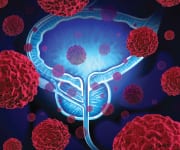Life Extension Magazine®
Metformin Inhibits Pancreatic Cancer Progression
 |
A report published in PLOS One reveals the discovery of researchers at Massachusetts General Hospital of a mechanism supporting metformin’s ability to reduce pancreatic cancer progression.*
Researchers examined the most common type of pancreatic cancer known as pancreatic ductal carcinoma, which is associated with type II diabetes and insulin resistance. The scientists first found that levels of hyaluronan, a component of the extracellular matrix, were 30% lower in tumor samples from overweight or obese patients who were taking metformin to treat diabetes than in those who did not take the drug.
“We found that metformin alleviates desmoplasia, an accumulation of dense connective tissue and tumor-associated immune cells that is a hallmark of pancreatic cancer, by inhibiting the activation of the pancreatic stellate cells that produce the extracellular matrix and by reprogramming immune cells to reduce inflammation,” reported co-senior author Dai Fukumura, MD, PhD. “We also found these effects only evident in tumors from overweight or obese individuals, who appear to have tumors with increased fibrosis.”
Editor’s Note: Earlier research has uncovered a lower risk of pancreatic cancer in diabetics treated with metformin, as well as a reduced risk of mortality among those who develop the disease. The Life Extension Foundation is currently funding a clinical study whereby metformin is a component of the pancreatic treatment protocol.
*PLOS One. 2015 Dec 7.
Eating Fish Reduces Alzheimer’s Risk
 |
A new study published in JAMA found that eating fish and other seafood at least once a week may help lower the risk of Alzheimer’s disease, despite higher levels of mercury in the brain from the fish.*
The study included 544 volunteers who answered weekly questionnaires for more than four years asking if they consumed a variety of seafood. A total of 286 of the participants allowed their brains to be autopsied after death.
Tissue samples from the autopsied brains were measured for brain metal concentrations and evidence of dementia, including strokes, plaques, tangles in the brain indicative of Alzheimer’s disease, and Lewy bodies that are associated with Parkinson’s disease.
Martha Clare Morris, professor of epidemiology at Rush University Medical Center, and colleagues revealed that even though participants who ate seafood once a week or more had higher levels of mercury in the brain, the pathological signs of Alzheimer’s disease were lower. These findings were significant among people with the common genotype (ApoE4) linked to a higher risk of developing Alzheimer’s disease and their risk was reduced when they ate a moderate amount of seafood.
Editor’s Note: “A major concern in public health was whether the increased mercury exposure that comes from consuming seafood might have harmful effects on the brain as we age. This study provides evidence that the increased mercury exposure is not correlated with increased brain pathologies associated with dementia,” said Morris. Highly purified EPA/DHA extracted from molecularly distilled fish oils has no detectable levels of mercury or other heavy metals. Whole seafoods, on the other hand, contain varying levels of heavy metals.
*JAMA . 2016;315(5):489-97.
Vitamin D Supplementation Improves Premenstrual Symptoms
 |
An article in the Journal of Pediatric & Adolescent Gynecology reveals women with premenstrual syndrome benefit by supplementing with vitamin D.*
The current trial included 158 young women with severe cognitive and emotional premenstrual syndrome symptoms and deficient serum 25-hydroxyvitamin D levels. Participants received a placebo or 200,000 IU vitamin D followed by 25,000 IU every two weeks for four months. Vitamin D levels were tested at the beginning of the study and monthly thereafter. All participants completed questionnaires that assessed symptoms during each of the four cycles included in the study.
Vitamin D levels significantly improved after one month among those who received the supplement. Subjects who received vitamin D showed improvement in anxiety, irritability, crying easily, sadness, and disturbed relationships by the end of the study, whereas no significant changes in symptom intensity were noted by those who received a placebo.
Editor’s Note: “Based on the present findings,” the authors write, “vitamin D therapy can be suggested as a safe, effective, and convenient method for reducing the intensity of premenstrual syndrome mood disorders and consequently improve the quality of life in young women with severe hypovitaminosis D and concomitant mood disorders associated to premenstrual syndrome.”
*J Ped Adolesc Gynecol. 2015 Dec 24.
Sleeping In On Weekends Reduces Diabetes Risk
 |
An article published in Diabetes Care found that sleeping in on the weekend could counteract the increased risk of diabetes associated with short-term sleep restriction during the work week.*
Researchers at the University of Chicago sleep laboratory recruited 19 volunteers, all healthy young men. On the first occasion, they slept normally, spending 8.5 hours in bed for four nights. On another occasion, the same volunteers were allowed only 4.5 hours in bed for four consecutive nights. They spent an average of 4.3 of those hours asleep each night. They were then allowed two nights of extended sleep, during which they averaged 9.7 hours of sleep.
Investigators determined the subjects’ insulin sensitivity—the ability of insulin to regulate blood sugars—and the disposition index, a predictor of diabetes risk. After four nights of sleep restriction, the volunteers’ insulin sensitivity decreased by 23% and their diabetes risk increased by 16%.
After two nights of extended sleep, however, insulin sensitivity and the risk of diabetes returned to normal.
Editor’s Note: An increased risk of diabetes is not the only health concern of too little sleep, say the authors. Chronically sleep-deprived people are more likely to develop other health problems such as increased inflammation, high blood pressure, and cognitive problems. They also tend to eat more, especially sweets and high-fat foods, a diabetes risk in itself.
*Diabetes Care . 2016 Jan 19.
Brain Inflammation Occurs 20 Years Ahead of Alzheimer’s Symptoms
Approximately 20 years before any symptoms of Alzheimer’s disease appear, inflammation in the brain can be seen, according to a report published in the journal Brain.*
The findings of researchers at Sweden’s Karolinska Institute suggest that activation of astrocytes (glial cells in the brain and spinal cord) at an early stage greatly influences the development of the disease.
Researchers recruited family members of people with Alzheimer’s mutations who have a much higher risk of developing the disease. The researchers looked for and examined any changes that took place during the very early stages. They also recruited patients with non-inherited, “sporadic” Alzheimer’s disease as a comparison group.
All participants in the study underwent memory tests and scans using PET (positron emission tomography), which allows radioactive tracer molecules to be introduced into the brain via injection into the blood.
Participants who carried the known mutations were found to have amyloid plaque and inflammatory changes almost two decades before the onset of cognitive problems. The number of astrocytes reached a peak when the amyloid plaque started to accumulate in the brain.
Furthermore, neuronal function, as measured by glucose metabolism, began to decline roughly seven years before disease symptoms.
Editor’s Note: This study corroborates previous findings showing the devastating impact that inflammation inflicts on the brain.
*Brain. 2016 Jan 26.
High-Rise Residents Have Higher Risk of Cardiac Death
 |
According to a study published in Canadian Medical Association Journal, residents who live on the first or second floor of a high-rise building have a higher survival rate from cardiac arrest than those who live above them.*
Of 8,216 people who had cardiac arrests in private residences and were treated by 911-initiated first responders, 3.8% survived to be discharged from hospital. Of the 5,998 (73%) people living below the third floor who had cardiac arrests, 252 (4.2%) survived the arrest, but only 48 (2.6%) of the 1,844 people living above the third floor survived. When analyzed floor by floor, the researchers found a survival rate of only 0.9% in those living above the 16th floor and no survivors in those living above the 25th floor.
The study looked at the interval from arrival of an emergency vehicle to 911-initiated first responders reaching a patient. Other studies have measured response time between the call to 911 and arrival of an emergency vehicle on scene, but not the time it took to actually reach the patient.
Editor’s Note: The researchers outline several solutions to improve time to patient contact, such as giving 911-initiated first responders sole access to elevators for emergency service without public interference, similar to the access of firefighters during a fire; emergency alerts to building staff before arrival of the first responders; and better placement of defibrillators to increase bystander use.
*Can Med Assoc J. 2016 Jan 18.
Lower Screening Rates Could Delay Early Onset Prostate Cancer Treatment
 |
A study published in The Journal of Urology® provides a cautionary note to the recommendation by the US Preventive Services Task Force (USPSTF) against regular prostate specific antigen (PSA) screening for prostate cancer.*
The study found that men who did not have a PSA screening but later underwent a prostate needle biopsy had greater likeliness of being diagnosed with high-risk disease when compared with the time period prior to the USPSTF guidelines.
John M. Corman, MD, and colleagues examined data from 1,726 men who underwent needle biopsies of the prostate at Seattle’s Virginia Mason Medical Center from 2004 to 2014. Among the 310 men whose biopsies were conducted after the USPSTF recommendation, prostate-specific antigen levels were greater and diagnosis with higher clinical state and high-risk cancer were more common compared to those whose biopsies were performed earlier.
Editor’s Note: “The goal of prostate cancer screening is to maximize the benefit of screening tools such as prostate-specific antigen levels while minimizing the harm associated with over-diagnosis and overtreatment,” Dr. Corman observed. “Rather than relegating prostate-specific antigen levels into oblivion, the balanced answer may be best found in the more intelligent use of available tools, implementation of shared decision making as recommended by the American Cancer Society, and development of more effective screening techniques.”
*J Urol. 2016 Jan;195(1):66-73.
Increased Flavonoids Linked with Lower Erectile Dysfunction Risk
An article in the American Journal of Clinical Nutrition unveiled the finding of an association between greater intake of flavonoids and a lower risk of erectile dysfunction.*
For the current investigation, Aedín Cassidy and colleagues utilized data from 25,096 participants in the Health Professionals Follow-Up Study. Dietary questionnaire responses collected every four years beginning in 1986 were analyzed to determine the intake of flavanones, anthocyanins, flavan-3-ols, flavonols, flavones, and polymers/oligomers. Erectile function was rated by participants during 2000, 2004, and 2008.
Over 10 years of follow-up, erectile dysfunction was reported by 35.6% of subjects. Having an intake of flavones that was among the top 20% of participants was associated with a 9% lower adjusted risk of erectile dysfunction in comparison with the lowest 20%, and for those among the top 20% of flavanone and anthocyanin intake, the risk was 10% and 9% lower.
Beneficial foods include blueberries, cherries, blackberries, black currants, radishes, citrus, parsley, thyme, celery, and hot peppers.
Editor’s Note: “We examined six main types of commonly consumed flavonoids and found that three in particular—anthocyanins, flavanones, and flavones—are beneficial,” Dr. Cassidy observed. “Men who regularly consumed foods high in these flavonoids were 10% less likely to suffer erectile dysfunction. In terms of quantities, we’re talking just a few portions a week.”
*Am J Clin Nutr. 2016 Jan 13.
Cognitive Dysfunction Associated with Vitamin E Deficiency
 |
An article that appeared in the Journal of Nutritional Science and Vitaminology describes a study conducted at Japan’s Shibaura Institute of Technology that found an increase in cognitive dysfunction in vitamin E-deficient mice.* Animals that experienced long-term deficiency exhibited an increase in brain lipid peroxidation, indicating that a continual lack of vitamin E may accelerate brain oxidation.
The study included mice given either a standard diet or one that was vitamin E-deficient beginning at 1 month of age and continuing until the age of 3 or 6 months, followed by cognitive testing. Lipid peroxidation was measured in the cerebral cortex, cerebellum, and hippocampus, and serum cholesterol levels were assessed.
Deficient animals in both age groups showed impairments in cognitive function compared to mice that received a standard diet. They also had higher serum cholesterol levels in comparison with their age-matched controls.
Editor’s Note: While brain lipid peroxidation was similar between deficient and nondeficient 3-month-old mice, 6-month-old deficient mice exhibited a greater amount of peroxidation in the cortex and cerebellum in comparison with nondeficient mice of the same age, indicating a significant effect in association with long-term deficiency.
Vitamin B12 Deficiency Common among Long-Term Care Patients
 |
An article published in Applied Physiology, Nutrition, and Metabolism reports a significant number of patients with deficient vitamin B12 levels in a sample of patients residing in Canadian long-term care facilities.* The finding adds evidence to the benefit of blood testing for levels of B12.
Heather H. Keller and colleagues at Ontario’s University of Waterloo examined the charts of 412 long-term care residents over the age of 65 who had blood testing conducted upon admission. They found that 13.8% of the patients had levels of vitamin B12 that were diagnostic of deficiency (below 212 pg/mL) and less than half of the residents had normal levels greater than 407 pg/mL. Another 4% of the residents developed deficiencies within a year of admission. More favorable vitamin B12 status was strongly associated with supplementation, with 84% of those with normal levels taking B12 supplements upon admission.
Editor’s Note: “In spending time in long-term care homes, you often see depression and loneliness,” observed lead author Kaylen Pfisterer, assistant research coordinator at the Schlegel-University of Waterloo Research Institute for Aging. “This is why we need to do everything in our power to enhance quality of life and quality of care in this setting. Screening for B12 deficiency is a first step to targeting B12 treatment to those who may benefit most.”
*Appl Physiol Nutr Metab. 2016 Jan 19:1-4.
Aged Garlic Extract Reduces Arterial Plaque Burden
 |
A randomized trial reported in the Journal of Nutrition found a reduction in vulnerable plaque in the arteries of metabolic syndrome patients who supplemented with aged garlic extract.*
In the study, 55 men and women between the ages of 40 and 75 years were given 2,400 mg of aged garlic extract or a placebo orally for a year. Cardiac computed tomography angiography screening was conducted at the beginning and end of the treatment period to assess coronary plaque volume, including total plaque volume, dense calcium, noncalcified plaque, and low-attenuation plaque, which is vulnerable to rupture.
At the end of the study, participants who received aged garlic had experienced slower accumulation of total plaque compared to the placebo group, as well as regression of low-attenuation plaque.
Editor’s Note: “This study is another demonstration of the benefits of this supplement in reducing the accumulation of soft plaque and preventing the formation of new plaque in the arteries, which can cause heart disease,” commented lead researcher Matthew J. Budoff, MD. “We have completed four randomized studies, and they have led us to conclude that aged garlic extract can help slow the progression of atherosclerosis and reverse the early stages of heart disease.”
*J Nutr. 2016 Jan 13.

